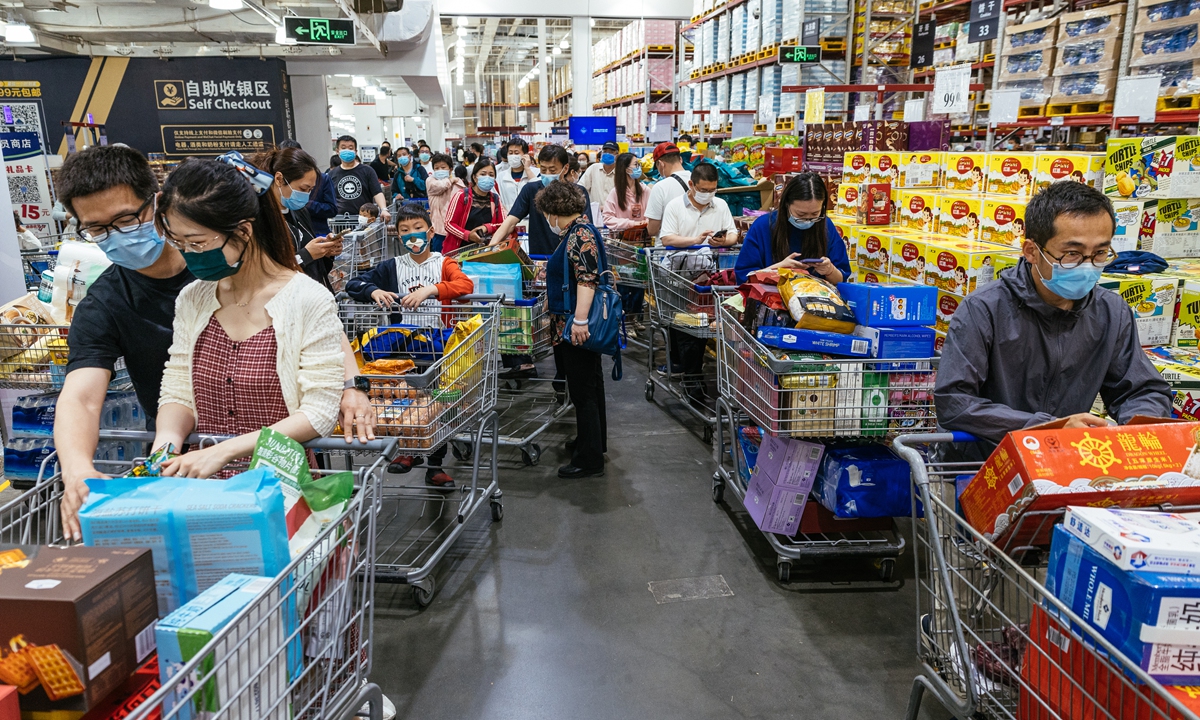
Some Beijing residents go shopping for food on April 24, 2022. Photos: Li Hao/GT
Beijing's Chaoyang district, home to some 3.5 million residents, will roll out three rounds of mass nucleic acid testing starting from Monday after the district registered the most COVID-19 cases in the capital's latest epidemic surge.
The test applies to those who are living and working in the district, which will be conducted respectively on Monday, Wednesday and Friday, the Chaoyang disease prevention and control leading team said in a notice on Sunday.
Chaoyang reported 11 new COVID-19 infections from Saturday afternoon to Sunday afternoon, taking the total tally within the district since Friday to 26. Among the positive cases were students, teachers and relatives of a middle school. A total of 1,230 people were labeled as close contacts and quarantined.
Two residential communities in Chaoyang district on Sunday were respectively labeled as a high-risk and medium-risk region for COVID-19.
Health experts believed that Beijing has already taken effective and strong measures to prevent the situation from getting worse, and the results of the mass nucleic acid testing will be an index for the capital city to decide whether to take further anti-epidemic measures such as locking down some areas.
Residents in Chaoyang are urged to take a test before going to work on Monday and reduce their social activities as much as possible. "The expanded testing is to contain and cut off surging COVID-19 infections, and protect the health and lives of residents," the local anti-epidemic team said.
Amid the virus surge, some areas in Chaoyang with the presence of COVID-19 cases saw panic shopping, and several markets suffered a temporary shortage of fresh vegetables on Sunday afternoon, local media reported.
To ease the situation, Beijing's fresh food e-commerce companies immediately activated emergency response mechanisms to allocate and increase the supply of groceries including meat, poultry, eggs, milk, fresh fruits and vegetables.
The Beijing Municipal Commercial Affairs Bureau also stressed at the press conference on Sunday that supplies of daily necessities are sufficient in Beijing and traffic links to goods supplies are operating normally.
At around 8 pm, in a visit to a large supermarket in the Taiyanggong neighborhood in Chaoyang, a Global Times reporter found that all the trolleys at the entrance of the supermarket were in use. The fresh food and vegetable section had the largest number of shoppers, with dozens of people lining up to buy vegetables.
Some customers told the Global Times on Sunday that they chose to come in to buy some supplies after seeing reports of new cases for fear that the epidemic situation worsens.
Many e-commerce food platforms reported a lack of distribution capacity when residents tried to buy food online late on Sunday.
Zhao Weidong from the bureau said the agency had urged main e-commerce platforms to increase their stockpiles of goods and add workers to meet the surging demand of consumers.
Experts viewed the response by Beijing's public as one of drawing lessons from the Shanghai outbreak, where residents suffered shortages of food in the fight against the coronavirus.
A senior expert from the Chinese Center for Disease Control and Prevention told the Global Times on condition of anonymity that drawing lessons from the Shanghai outbreak and flare-ups in other provinces, Beijing should be able to deal with the COVID-19 resurgence more effectively.
Since the outbreak, Beijing has taken "strong" epidemic prevention and control measures in a bid to contain the resurgence - conducting nucleic acid testing as much as possible, carrying out very precise epidemiological investigations and sealing off any regions with virus risk, the expert said.
As for whether Beijing will end up with locking down the city or partially locking it down, he said it depends on the range of infections transmitted in Beijing. "When results of the nucleic acid testing in Chaoyang and other areas come out, it will give us a picture of the overall epidemic situation in Beijing. More measures will follow in accordance with it."
Since Friday, the total positive domestically transmitted COVID-19 tally in the capital surged to 42 cases, involving six districts in total.
Among the cases were teachers, students, interior decoration workers, a delivery man, and a chef working at a restaurant, diners and elder people in a tour group.
The virus has sneakily spread in the city for a week and multiple generations of cases were presented, Tian Wei from the Beijing Municipal government said at Sunday's press conference, indicating more COVID-19 transmissions are likely to be discovered.
Tian urged Beijing to act swiftly to contain the epidemic flare-up. "Once an epidemic is discovered, relevant measures should be in place on the same day. Nucleic acid testing should be well organized and will be expanded if the epidemic develops."
Pang Xinghuo, deputy director of the Beijing municipal disease prevention and control center, warned of escalating risks in the capital posed by imported cases, outbreaks outside Beijing as well as increased flows of people during the upcoming Labor Day holiday.
Gene sequencing samples of four positive COVID-19 infections in Beijing belonged to the Omicron variant and were linked to cluster outbreaks outside Beijing, Pang said.
Nearly one-quarter of the infected people are aged 60 and above, and 50 percent of these people have not been vaccinated, Pang said.




